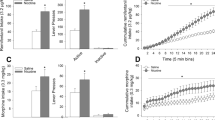Abstract
Many psychoactive drugs, including the opiates, have been shown to have paradoxical reinforcing effects1,2. Opiates produce positive reinforcing effects when they are paired with visual and textural environmental stimuli in rats3,4, yet, at similar doses and over the same routes of administration, produce aversive effects, as shown when they are paired with taste stimuli5. Similarly, in human, the positive reinforcing effects of opiates are well known to addicts and recreational drug users, yet patients receiving opiates as analgesics often report nauseous reactions. At present there is no evidence to differentiate between the neural substrates that mediate these opposite motivational effects. We now report an initial step in the resolution of this paradox by demonstrating that endogenous and exogenous opioids produce positive reinforcing effects through an action on brain opiate receptors, and aversive effects through an action on peripheral opiate receptors (especially in the gut).
This is a preview of subscription content, access via your institution
Access options
Subscribe to this journal
Receive 51 print issues and online access
$199.00 per year
only $3.90 per issue
Buy this article
- Purchase on Springer Link
- Instant access to full article PDF
Prices may be subject to local taxes which are calculated during checkout
Similar content being viewed by others
References
Cappell, H. & Leblanc, A. E. Addictive Behav. 1, 55–64 (1975).
Wise, R. A., Yokel, R. A. & Dewitt, H. Science 191, 1273–1275 (1976).
Mucha, R. F. van der Kooy, D., O'Shaughnessy, H. & Bucenicks, P. Brain Res. 243, 91–105 (1982).
Weeks, J. R. Science 138, 143–144 (1962).
van der Kooy, D. & Phillips, A. G. Pharmac. Biochem. Behav. 6, 637–641 (1977).
van der Kooy, D., Mucha, R. F., O'Shaughnessy, M. & Bucenieks, P. Brain Res. 243, 107–117 (1982).
Ninkovic, M., Hunt, S. P. & Gleave, J. R. W. Brain Res. 241, 197–206 (1982).
van der Kooy, D. Neurosci. Lett. Suppl. 10, S498 (1982).
Valentino, R. J., Herling, S., Woods, J. H., Medzihradsky, F. & Merz, H. J. Pharmac. 217, 652–659 (1981).
Martin, J. R., Rogers, R. C., Novin, D. & van der Weele, D. A. Bull. psychon. Soc. 10, 291–294 (1977).
Author information
Authors and Affiliations
Rights and permissions
About this article
Cite this article
Bechara, A., van der Kooy, D. Opposite motivational effects of endogenous opioids in brain and periphery. Nature 314, 533–534 (1985). https://doi.org/10.1038/314533a0
Received:
Accepted:
Issue Date:
DOI: https://doi.org/10.1038/314533a0
This article is cited by
-
Use of TAI-FISH to visualize neural ensembles activated by multiple stimuli
Nature Protocols (2018)
-
Visualizing an emotional valence map in the limbic forebrain by TAI-FISH
Nature Neuroscience (2014)
-
Failure of rewarding and locomotor stimulant doses of morphine to promote adult rat 50-kHz ultrasonic vocalizations
Psychopharmacology (2012)
-
Alteration of intravenous nicotine self-administration by opioid receptor agonist and antagonists in rats
Psychopharmacology (2010)
-
The insula and drug addiction: an interoceptive view of pleasure, urges, and decision-making
Brain Structure and Function (2010)
Comments
By submitting a comment you agree to abide by our Terms and Community Guidelines. If you find something abusive or that does not comply with our terms or guidelines please flag it as inappropriate.



